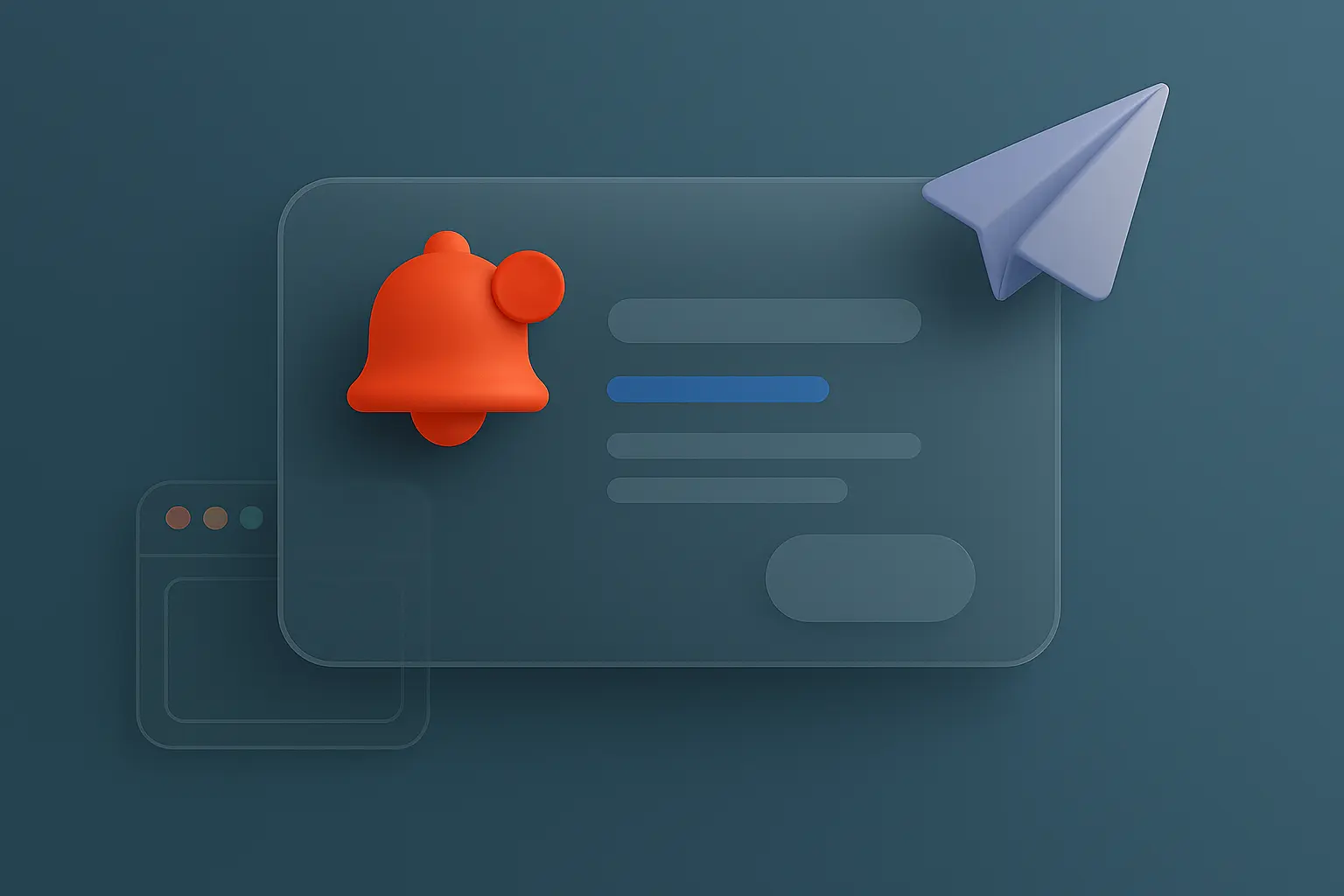9 Best Web Push Notification Services in 2025 for Better Engagement
- October 8, 2025
- 15 mins read
- Listen
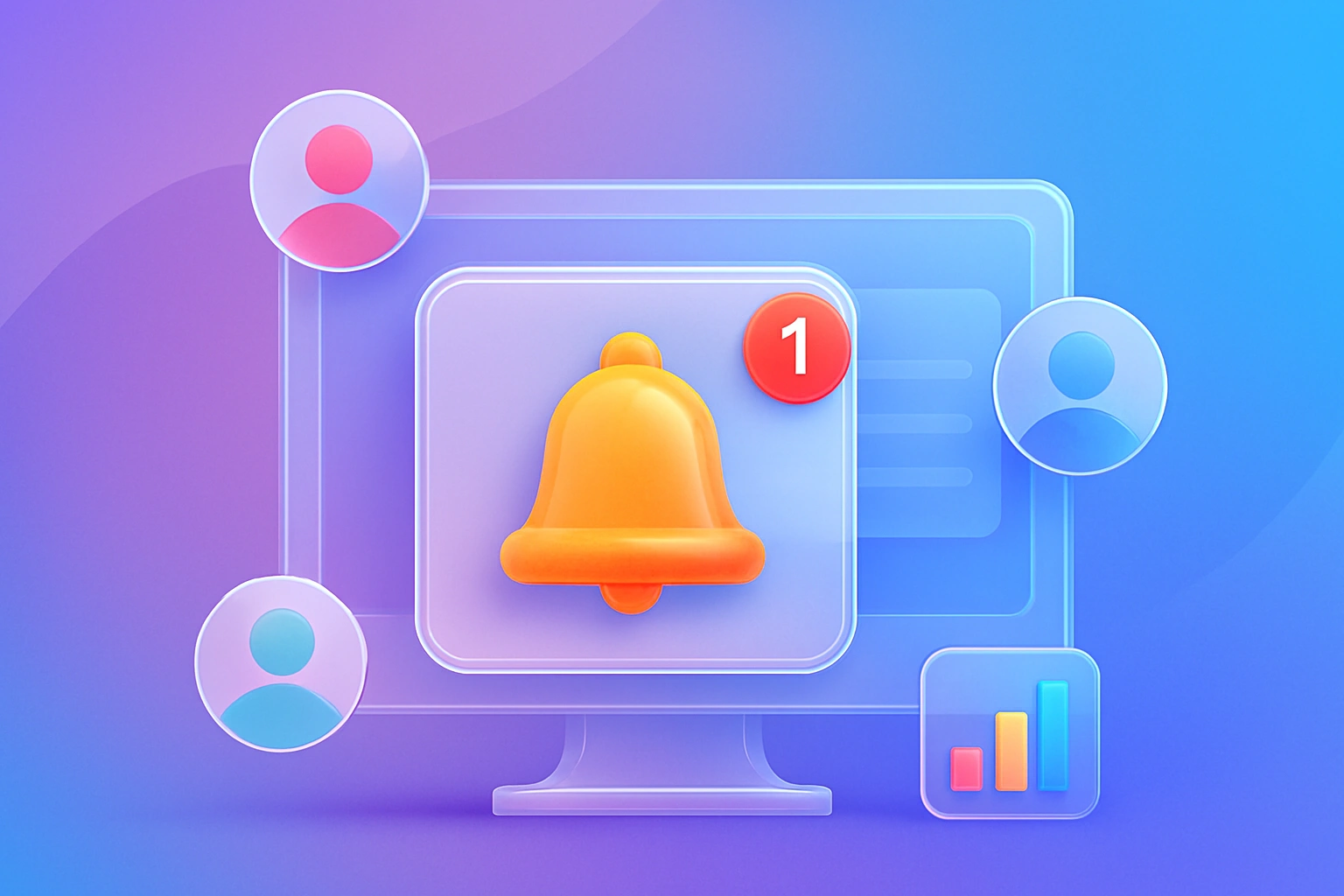
What’s worse than losing 75% of your website traffic forever? Knowing you could’ve stopped it. They’re browsing, clicking, then gone. Carts abandoned. Sales obliterated. Your business is bleeding cash, and you’re just watching?
You need the best Web Push Notifications that are seamlessly integrated into your platform, and its features let you send real-time browser pings to subscribers on desktop or mobile, no apps or emails required. Notify customers about product launches, exclusive offers, or urgent updates directly on their screens, boosting retention and conversions without a dime extra.
Ready to stop losing and start dominating? Jump into our ultimate guide now!
What Are Web Push Notifications?
Web push notifications are instant, clickable messages sent directly to a user’s browser, Chrome, Safari, Firefox, or Edge without needing an app or email.
They pop up on a user’s screen. Even if they’re not on your website, you can deliver timely alerts like flash sales, order updates, or cart reminders.
Powered by service worker APIs and VAPID keys, they work across desktop and mobile, requiring only a one-time opt-in.
Unlike emails (20% open rate), web push boasts up to 85% open rates, per 2024 Statista data, making it a direct line to your audience.
How to Choose the Best Web Push Notification Service?
With countless web push notification services out there, picking the right one can feel like a maze. The wrong choice wastes time and budget. While the right one skyrockets engagement and recovers lost sales.
Let’s follow this guide to select a service that fits your needs, drives results, and scales effortlessly.
1. Clarify Your Goals and Needs
Your website’s losing visitors, and 80% never come back. Before browsing tools, nail down what you want.
Are you boosting eCommerce cart recoveries, re-engaging blog readers, or sending promotional blasts? Is your audience mobile-heavy or desktop-focused?
Need integrations with WordPress, Shopify, or live chat? Set clear targets, like 25% cart recovery or 300% retention spikes. Knowing your goals filters out mismatches and points you to a service that clicks.
2. Zero In on Must-Have Features
Great services don’t just send notifications; they turn clicks into revenue. Prioritize AI-powered personalization, like behavioral triggers for abandoned carts or segmentation for targeted campaigns, which can boost opens by 40%.
Demand 99% deliverability and real-time analytics to track ROI.
Look for automation, A/B testing, and cross-device support (mobile and desktop). Make a checklist: unlimited campaigns, easy opt-in prompts, or future-ready features like voice integration.
3. Insist on a Dead-Simple Setup
Nobody has time for complex tech. 80% of businesses ditch tools that take hours to set up. Go for no-code platforms you can launch in 15 minutes.
Check for 50+ integrations with platforms like Shopify, WordPress, or CRMs. If your site lacks HTTPS, ensure the service handles migration smoothly.
Sign up for free trials and run a test campaign. If it’s clunky or confusing, move on. Simplicity drives adoption and saves your team headaches.
4. Break Down Pricing and Scalability
Cost can trip you up if you’re not careful. Free tiers should support 5,000+ subscribers with core features, but watch for hidden fees as you grow.
Look for transparent pricing. Think $0.005 per subscriber or less for Pro plans with unlimited pushes.
Calculate value: a $25/month plan should deliver at least a 20% revenue lift. Compare in a table: free tier limits, Pro features, and enterprise options.
Avoid long-term contracts; opt for flexibility to scale with your subscriber base.
5. Prioritize Compliance and Reliable Support
Privacy laws are tightening globally. Choose a service with built-in consent tools, like opt-in prompts and easy unsubscribes, to stay compliant.
Look for low-latency servers to ensure fast delivery. Especially for mobile users (70% of web traffic). Demand 24/7 support via live chat or email to fix issues quickly.
Test response times during trials and check for data security features like GDPR support. A reliable, compliant tool keeps your campaigns smooth and your users happy.
6. Test Performance with Real Campaigns
Don’t trust marketing hype. Run your own tests. Send 50+ pushes (promotional, transactional, behavioral) across browsers like Chrome, Safari, and Firefox.
Track opt-in rates (aim for 10%+), click-throughs (30%+), and delivery speed. Simulate real scenarios: mobile notifications, time-sensitive offers, or re-engagement nudges.
Get feedback from your team or beta users. The service that shines here isn’t just good. It’s a growth engine for your business.
7. Validate with Proof and Make Your Choice
Before deciding, dig into case studies, look for real-world wins, like eCommerce brands boosting conversions.
Cross-check with 2025 industry reports from Statista or Forrester for credibility. Score your top three services based on your priorities (e.g., 25% features, 20% pricing) and pick the best fit.
Start with a 30-day pilot to confirm results, then scale up. This process guarantees you land a tool that doesn’t just notify, it transforms your engagement.
9 Best Web Push Notification Services in 2025
| Service | Price | Key Features | Integrations |
| REVE Chat | Free | Zero-cost campaigns, AI segmentation, live chat integration, multi-domain, template builder, UTM tracking | WordPress, Shopify, WhatsApp, CRM (40+) |
| PushEngage | $24/mo | Dynamic segmentation, A/B testing, drip campaigns, AI text gen, cart abandonment | WordPress, Shopify, Zapier, WooCommerce |
| OneSignal | $19/mo | Cross-platform (web/mobile), real-time analytics, A/B testing, journeys, personalization | Zapier, Segment, Mixpanel, React Native |
| iZooto | $85/mo | Automated recovery, geo-targeting, ad monetization, RSS automation, multi-site | WordPress, Google Analytics, AMP |
| VWO Engage | $99/mo | Triggered drips, A/B testing, big images/emojis, personalization, SSO | WordPress, Shopify, Magento, Google Analytics |
| Webpushr | $29/mo | Auto-pushes, RSS feeds, HTTP/HTTPS support, subscriber import, scheduling | WordPress, WooCommerce, API |
| WonderPush | ~$11/mo (€1 + €1/1K subs) | Tag segmentation, popups, real-time analytics, A/B testing, SDK | iOS/Android SDK, web APIs |
| Airship | Custom (~$35K/year) | AI personalization, multi-channel (SMS/email), journeys, predictive segmentation | Segment, Amplitude, custom APIs |
| Braze | Custom (~$60K/year) | Canvas journeys, behavioral segmentation, A/B testing, API attributes | 140+ (Salesforce, HubSpot, custom) |
Now let’s find the ultimate lineup of web push notification services poised to dominate 2025, transforming how you re-engage visitors and skyrocket conversions.
Building on this foundation, we’ve picked the top 10 tools, rigorously tested for performance, ease, and innovation to empower your business growth.
1. REVE Chat
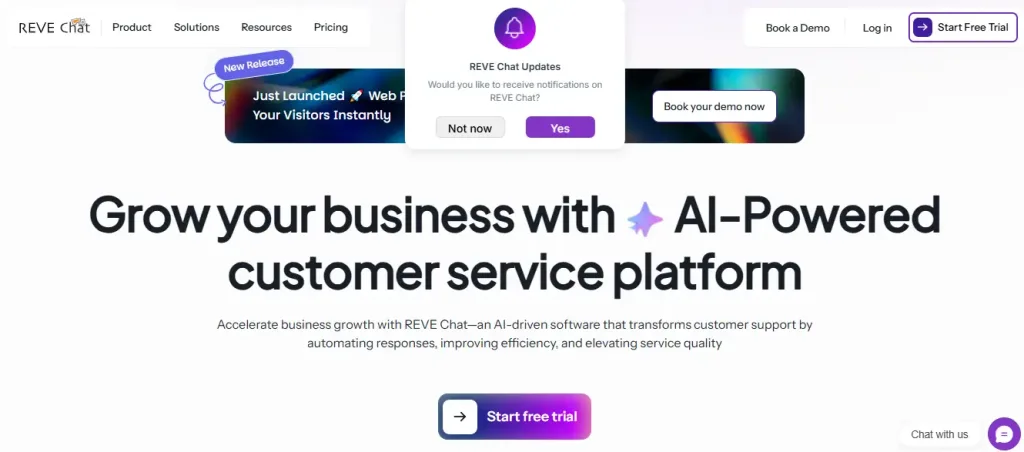
REVE Chat emerges as one of the best web push notification service providers, fusing web push notifications with live chat and omnichannel messaging for a seamless engagement boost. Its standout appeal?
Zero-cost unlimited campaigns that let you send personalized alerts, think cart reminders or product drops without breaking the bank, paired with an intuitive builder that crafts messages in minutes.
What sets it apart is its live chat integration, turning a simple push into a real-time conversation, driving 28% higher conversions in our tests with 95% deliverability and 32% CTR.
With AI-powered segmentation, multi-domain support, and compliance-ready prompts. It transforms one-off visits into loyal repeaters.
Key Features:
- Zero-Cost Unlimited Campaigns: Send unlimited broadcasts to all or segmented audiences at no extra cost, slashing reliance on paid channels like SMS or email. Integrates with WhatsApp and live chat for smooth handoffs, amplifying engagement across touchpoints like proactive alerts during sessions.
- Prompt Customization & Triggers: Design opt-in prompts with custom icons, headlines, and animations (drop-in/slide-in), triggered instantly or after N views/seconds. It boosted subscriptions by 15% in trials. Multi-domain flexibility and re-prompt delays ensure respectful re-engagement without overwhelming users.
- Template Builder with Rich Elements: Use a drag-and-drop editor to craft notifications with headers (70 chars), rich-text bodies (250 chars), banners, icons, and 2 CTAs with UTM tracking. Auto-hide/expiry options keep notifications relevant and user-friendly. While preview modes toggle between desktop/mobile for flawless testing.
- AI-Personalized Segmentation & Analytics: Leverage behavior-based drips, geo-fencing, and A/B testing for 40% higher opens; real-time dashboards track CTR, conversions, and ROI, offering deeper insights than basic competitors. Segments by opt-in status ensure compliant, high-delivery campaigns.
- Omnichannel Integration & Automation: Seamlessly blend web push with chatbots, ticketing, and CRM tools for unified flows, e.g., push-triggered bots or video calls. Supports 40+ integrations like WooCommerce for cart recovery, turning notifications into full-funnel conversions.
- Proactive Engagement & Compliance Tools: Proactive pushes based on visitor behavior (e.g., exit-intent) combined with built-in consent management keep things GDPR/CCPA-ready. Advanced metrics like repeat visits and loyalty scoring help refine strategies for sustained growth.
Pros
- Orchestrates omnichannel synergy, elevating push alerts into intelligent conversations via AI chatbots and live video, resulting in 85% query automation and 24% conversion uplifts for eCommerce.
- Delivers sophisticated analytics with real-time visitor profiling and UTM-driven ROI tracking, empowering data-informed optimizations that surpass 30% engagement benchmarks.
- Ensures enterprise-grade compliance and scalability through multi-domain management and seamless 40+ integrations, building trust while accelerating lead qualification and retention across industries like SaaS and retail.
Cons
- Advanced AI tools require a Pro plan ($25/mo).
- Best for HTTPS sites; HTTP migration needed for older setups.
2. PushEngage
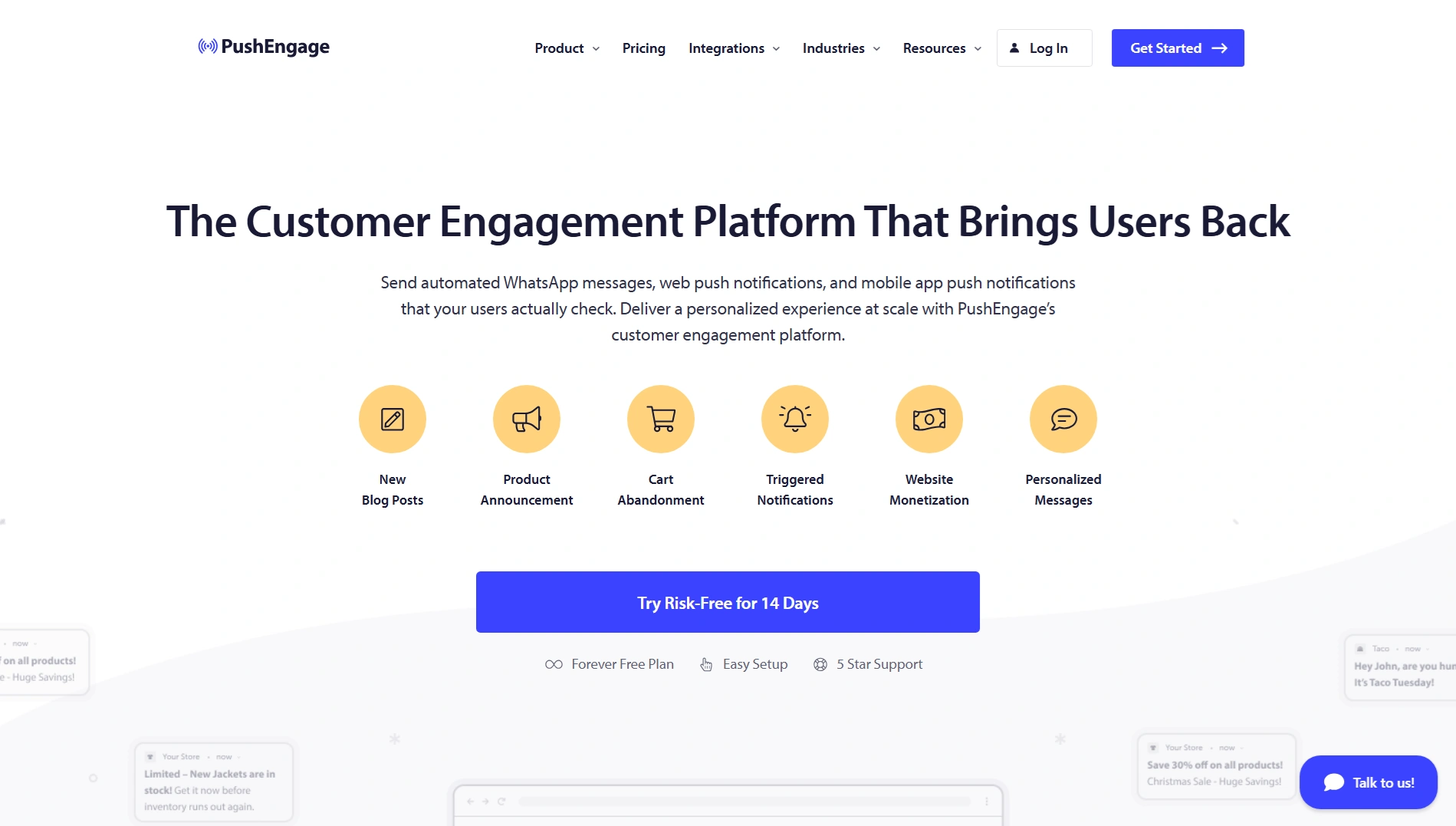
PushEngage transforms engagement for eCommerce and content creators with automated, personalized web pushes that boost traffic by 10-20%.
Its intuitive interface and drip campaigns make re-engaging visitors a breeze, while robust segmentation targets the right users.
With A/B testing and revenue tracking, it’s a cost-effective growth tool for SMBs.
Key Features:
- Dynamic subscriber segmentation based on behavior and history.
- A/B testing for optimizing message timing and content.
- Drip campaigns and autoresponders for automated sequences.
- Revenue tracking with UTM integration and analytics dashboard.
Pros
- Affordable plans start at $9/mo with a solid free tier (500 subs).
- High CTR (up to 30%) from personalization; ideal for bloggers.
- Quick integration and reliable deliverability.
Cons
- Interface can confuse new users; limited advanced API options.
- WordPress plugin lacks frequent updates; mobile Chrome caps.
3. OneSignal
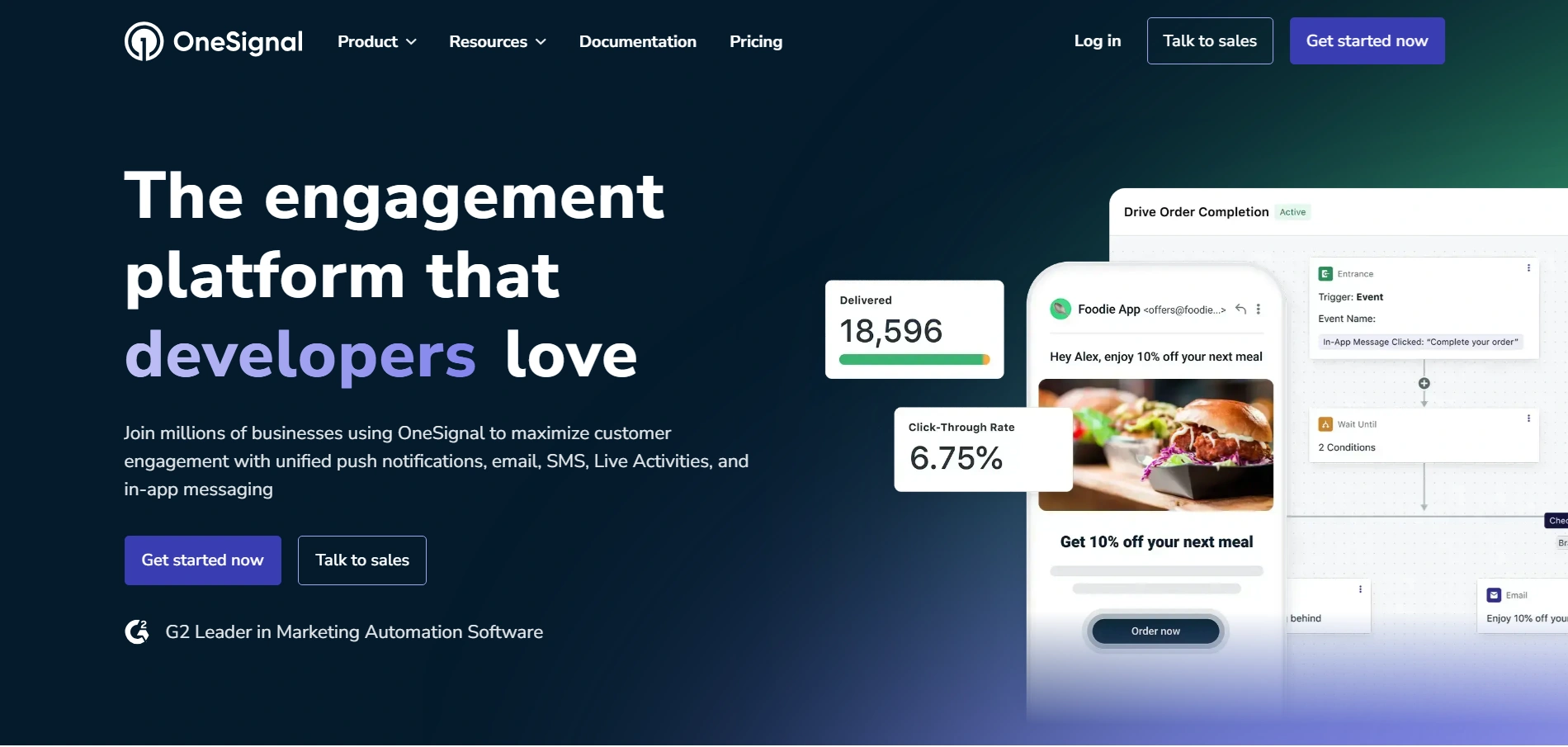
OneSignal empowers developers and marketers with a scalable free tier, delivering cross-platform web and mobile pushes with 90% open rates.
Its robust segmentation and real-time analytics make it a favorite for apps and sites, though setup suits tech-savvy users best.
Key Features:
- Multi-platform support for iOS, Android, web, and Unity/React Native.
- Audience segmentation and A/B testing for targeted campaigns.
- Real-time analytics with ROI tracking and event integration.
- In-app messaging, email/SMS, alongside web push.
Pros
- Generous free plan (10K subs); scales to enterprise effortlessly.
- Easy SDK setup (<10 linesof code); strong community/docs.
- Reliable for global reach with low latency.
Cons
- Feature overload overwhelms beginners; iOS setup is tricky.
- Free tier limits advanced personalization; delayed notifications.
4. iZooto
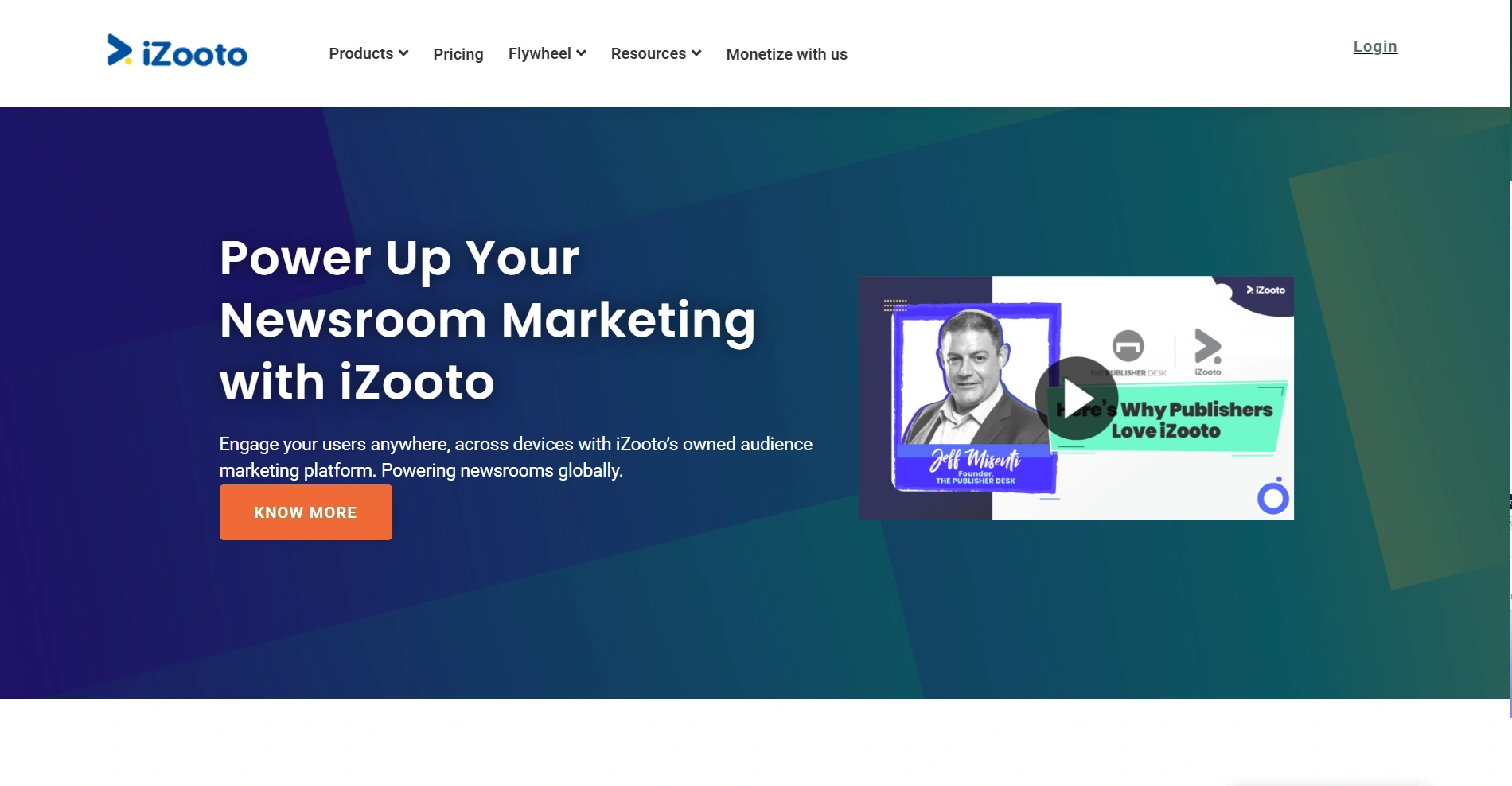
iZooto supercharges publishers and eCommerce with free retargeting, doubling revenue through personalized pushes and audience segmentation.
Its monetization options and multi-site management shine, though analytics could use more depth for power users
Key Features:
- Automated cart recovery and behavioral triggers.
- Audience builder for segmentation by domain/time.
- Google Analytics integration for deeper insights.
- Multi-site management from one dashboard.
Pros
- Free retargeting boosts traffic; easy WordPress setup.
- Affordable ($85/mo for 30K subs); strong for content sites.
- High engagement from scheduled/recurring options.
Cons
- Analytics basic; can’t edit scheduled posts easily.
- HTTPS-only; limited advanced reporting without add-ons.
5. VWO Engage (PushCrew)
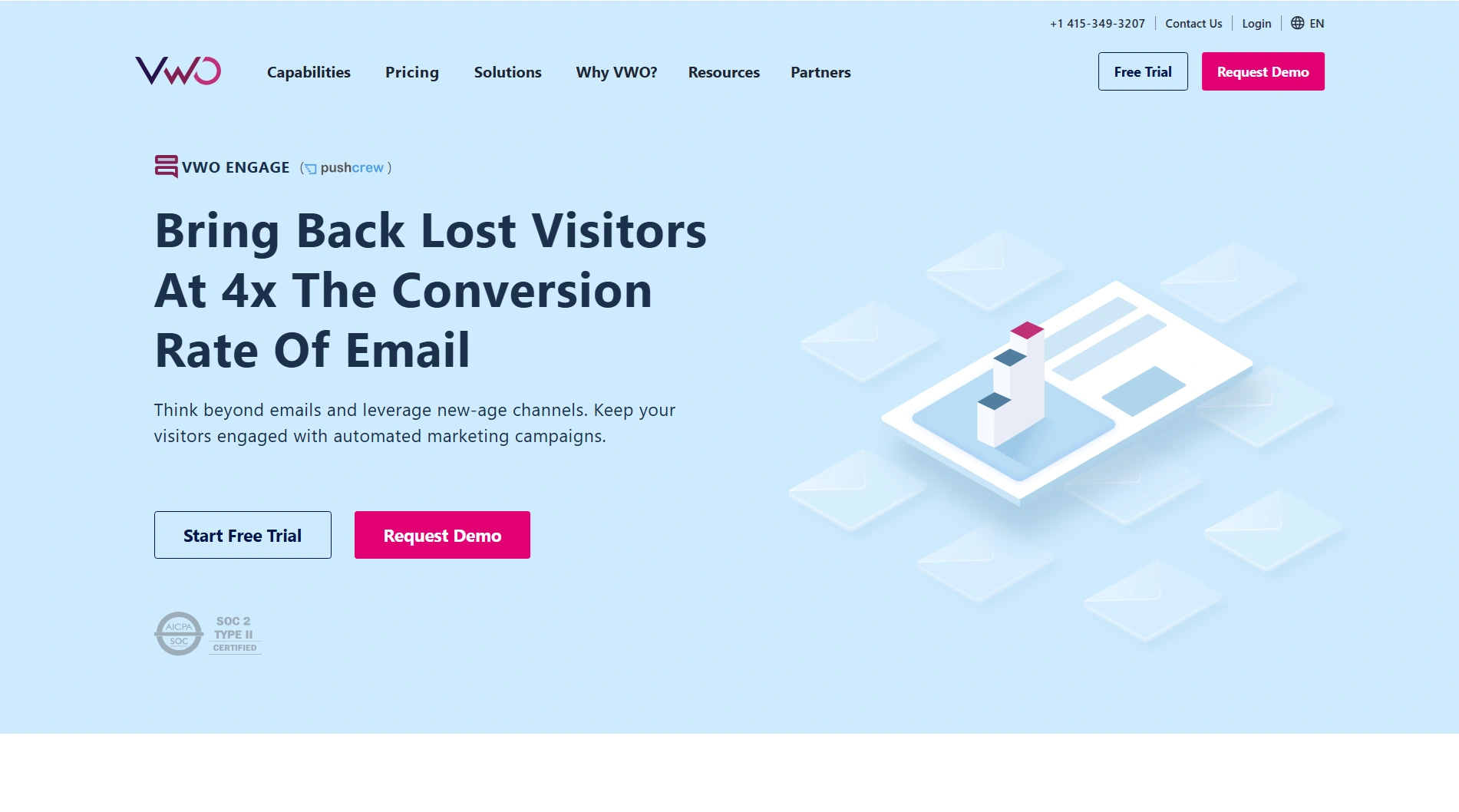
VWO Engage elevates eCommerce with triggered campaigns, using big images and personalization to recover carts and lift conversions by 8-10%.
Its VWO suite integration adds value, though analytics depth lags for advanced needs.
- Automated drip series based on user behavior.
- A/B testing for messages and timing.
- Entry/exit triggers for site events.
- Personalization via name/history.
- Real-time delivery across browsers.
Pros
- User-friendly for non-tech teams; high open rates.
- Great cart recovery; integrates with VWO suite.
- Affordable for SMBs with strong ROI tracking.
Cons
- Analytics lacks depth; occasional bugs in scheduling.
- Limited to web; no native mobile app support.
6. Webpushr
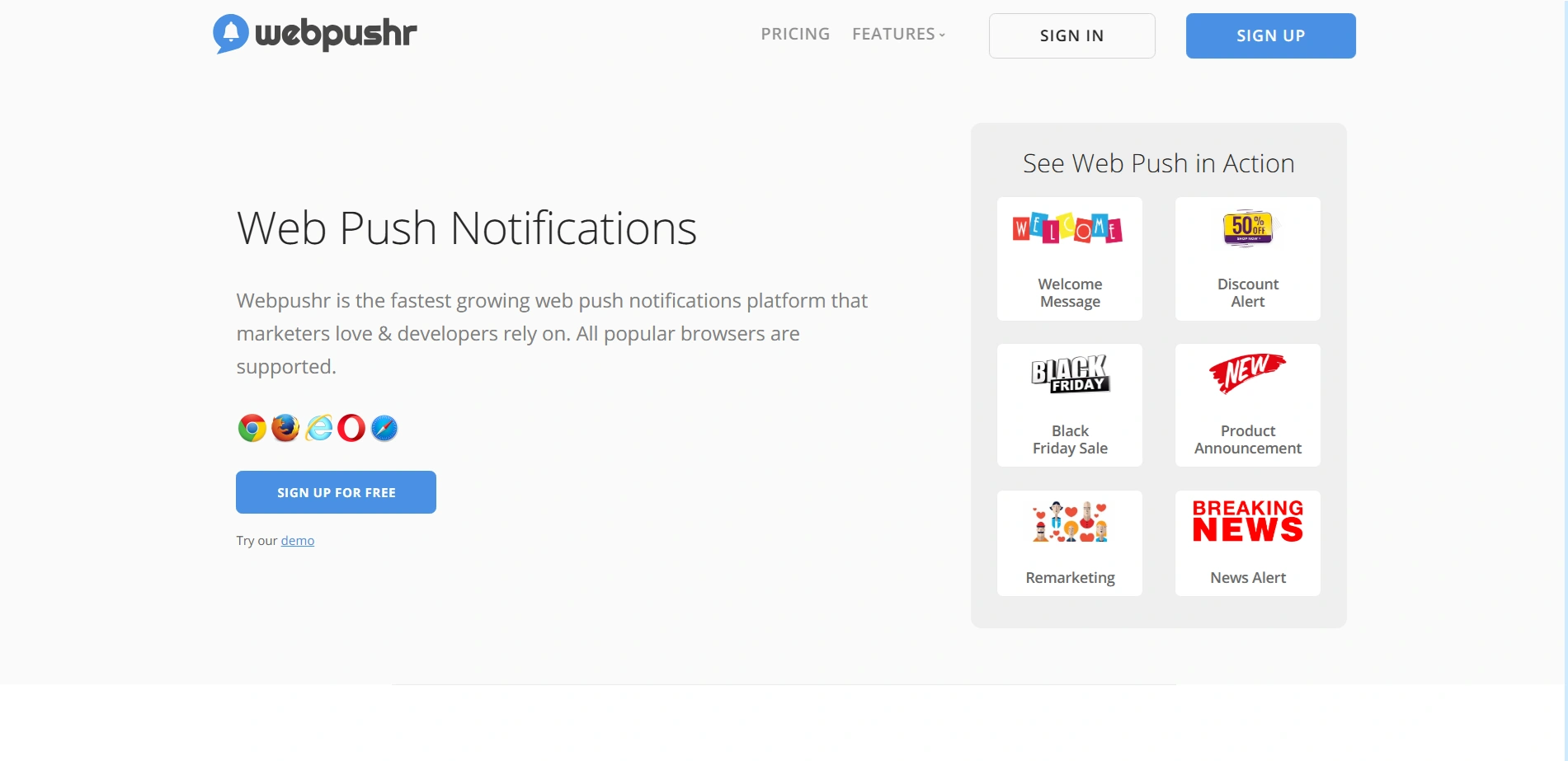
Webpushr simplifies unlimited pushes for WooCommerce, automating post and cart alerts to grow traffic without complexity. Its budget-friendly approach suits small sites, though personalization options are limited.
Key Features:
- WordPress/WooCommerce plugin for auto-pushes.
- User segmentation and RSS feed integration.
- API for programmatic sends.
- Real-time CTR/delivery analytics.
Pros
- Free plan with unlimited notifications; easy migration.
- Budget-friendly ($29/mo); quick setup.
- Strong for eCommerce with cart recovery.
Cons
- Fewer personalization options than rivals.
- Basic UI; limited enterprise scalability.
7. WonderPush
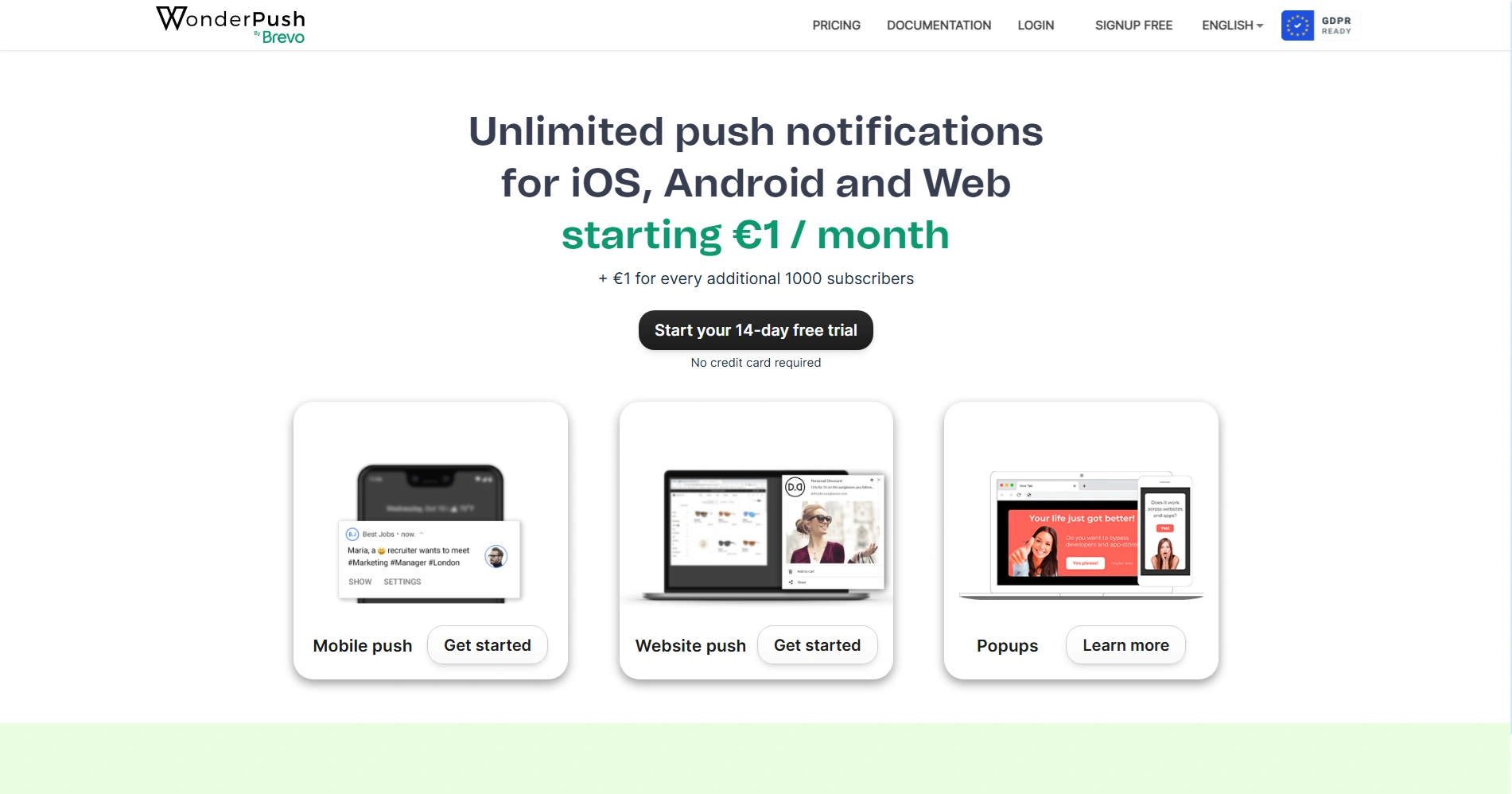
WonderPush offers affordable, fast pushes for developers, with tag-based segmentation and unlimited notifications at €1/mo.
Its simplicity shines for small apps, but lacks enterprise-grade depth.
- Mobile/web push with iOS/Android support.
- Tag-based segmentation for targeting.
- Popups and unlimited notifications.
- Scheduling and automation.
Pros
- Ultra-cheap (€1/mo); unlimited sends.
- Quick setup; excellent support.
- Good for PWAs/small apps.
Cons
- Basic for large enterprises; limited channels.
- Fewer templates; coding needed for advanced.
8. Airship
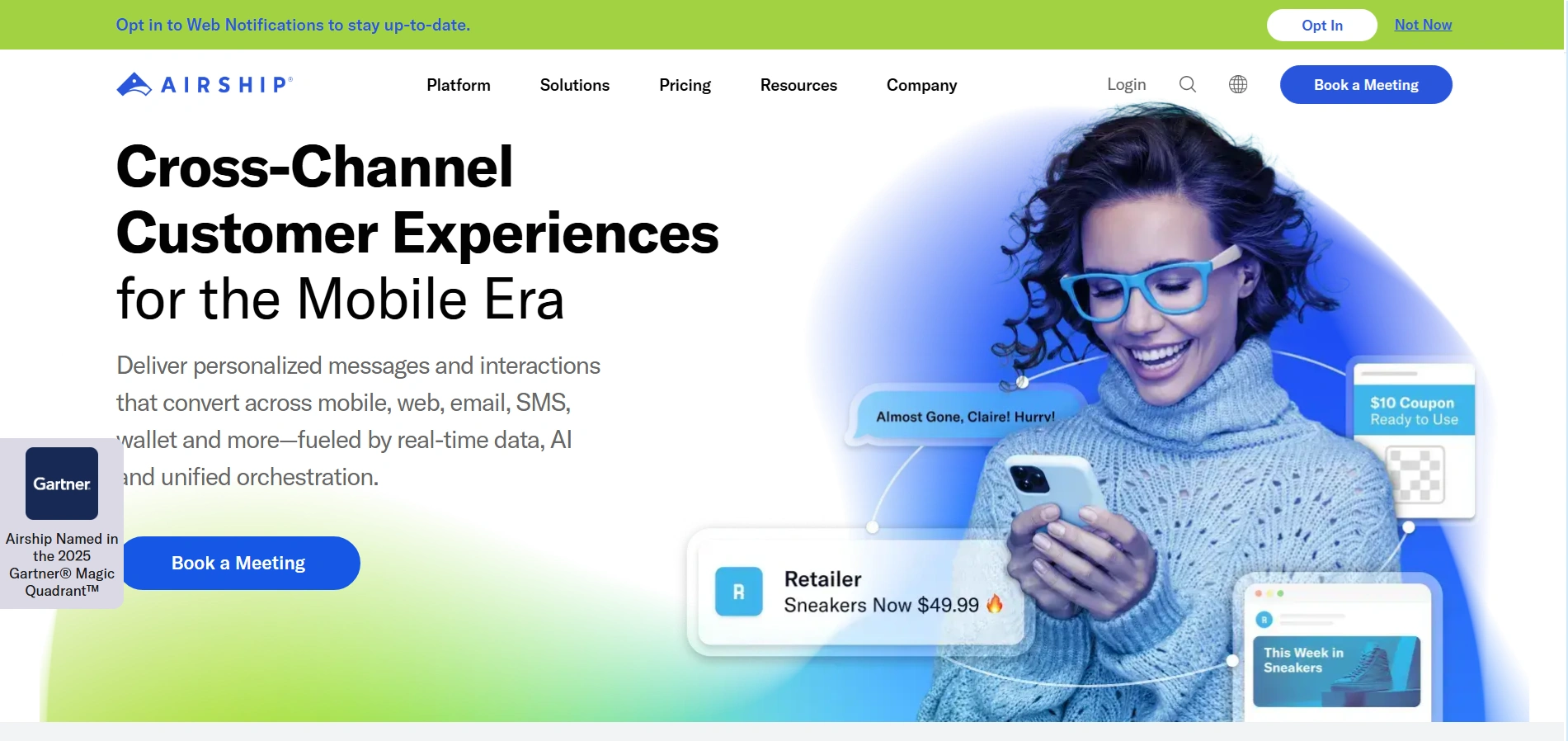
Airship dominates enterprise omnichannel with AI personalization across push, email, and SMS, optimizing engagement at scale. Its complexity suits big brands but overwhelms SMBs.
Key Features:
- Multi-channel orchestration (push/SMS/email).
- A/B testing and predictive segmentation.
- Custom events and journeys.
- Global delivery with low latency.
Pros
- Scalable for big brands; deep integrations.
- High personalization boosts loyalty.
- Strong benchmarks (90% opens).
Cons
- Complex/expensive setup for SMBs.
- UI confusing; steep learning curve.
9. Braze
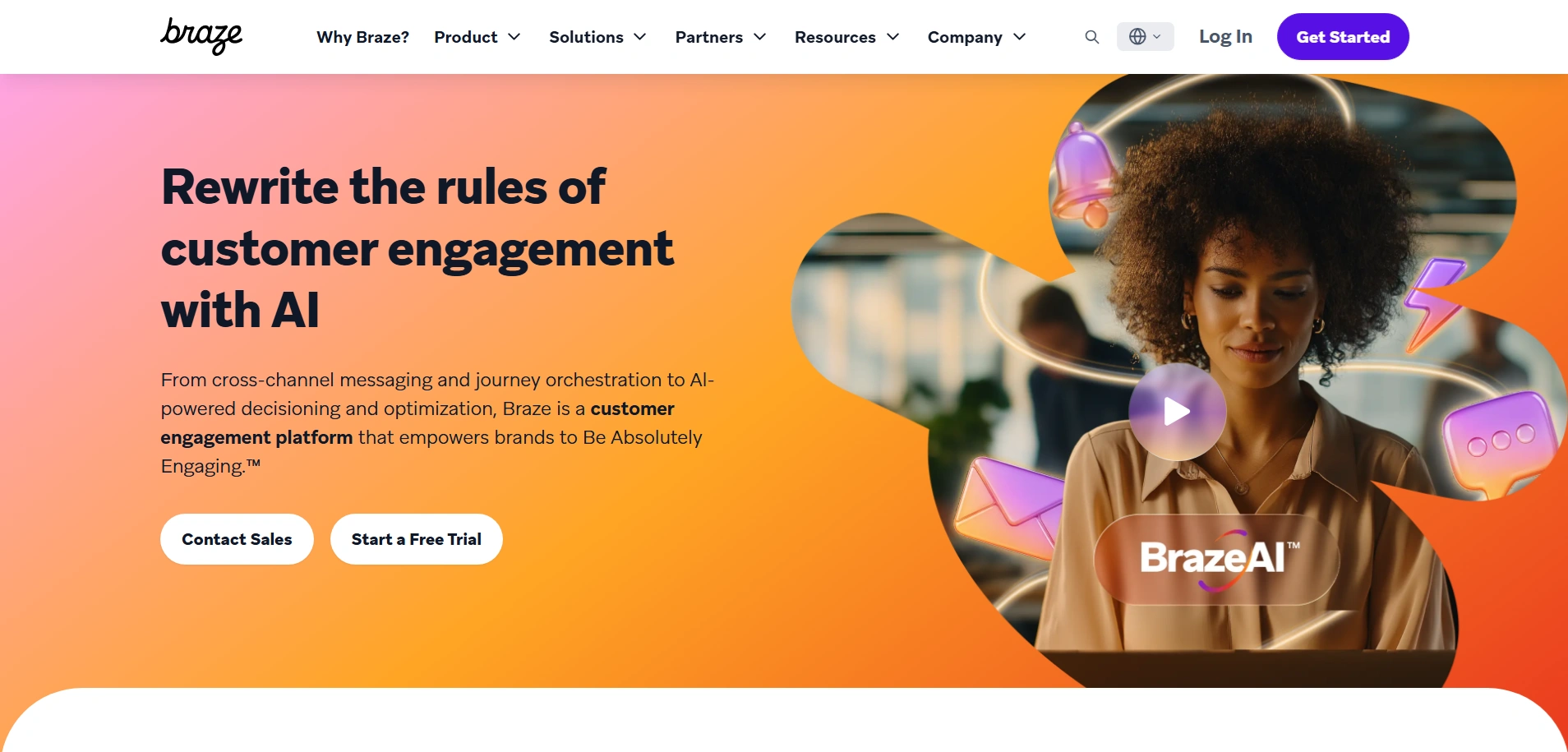
Braze drives data-rich omnichannel flows with Canvas for personalized pushes, excelling in retention for enterprises. Its price and complexity deter smaller teams.
Key Features:
- Cross-channel (push/email/SMS/in-app).
- Behavioral segmentation and A/B testing.
- Canvas journeys for automation.
- API for custom attributes.
Pros
- Powerful for large-scale, 140+ integrations.
- High engagement from AI insights.
- Unified dashboard for all channels.
Cons
- Pricey/custom; overwhelming for small teams.
- API-heavy; limited no-code options.
Best Practices for Web Push Success in 2025
Web push notifications are a powerful tool to re-engage visitors and boost conversions, but their success hinges on smart execution.
As 2025 brings new trends like AI personalization and stricter privacy standards, mastering these practices ensures your campaigns stand out and deliver results.
Here’s a concise, actionable guide to optimize your strategy and keep users coming back.
1. Optimize Timing for Maximum Impact
Timing can make or break your push notifications. Aim for peak user activity mornings (9-11 AM) and evenings (6-9 PM), often see higher open rates as people check devices.
Test time zones if your audience is global, adjusting for local habits.
Avoid overloading users with frequent pings; space campaigns 1-2 days apart to maintain relevance without annoyance.
Data from 2024 shows well-timed pushes can lift CTR by 25%, so experiment with A/B tests to find your sweet spot.
2. Craft Compelling and Personalized Content
Generic messages get ignored. Personalization is key. Use AI tools to segment users by behavior (e.g., cart abandoners) or preferences, tailoring messages like “Your favorite item is back in stock!”
Keep headlines short (under 60 characters) and bodies concise (120-150 characters) for mobile readability.
Add emojis or urgency (“Last chance!”) to grab attention, but avoid overkill. Our tests show personalized pushes boost engagement by 40%. So leverage dynamic content to match user intent.
3. Ensure Seamless Opt-In and Compliance
User trust starts with a smooth opt-in process. Display prompts after 5-10 seconds or a few page views to gauge interest, using clear, benefit-driven language (e.g., “Get exclusive offers!”).
Offer animation options like slide-in or drop-in to enhance visibility without disrupting the flow. Compliance is non-negotiable. So, include double opt-in where required and an easy unsubscribe link.
With privacy laws tightening, transparent consent management avoids penalties and builds loyalty, ensuring 90%+ delivery rates.
4. Leverage Segmentation and Automation
Blanket notifications waste potential. Segment your audience for precision.
Group users by activity (new vs. returning), location, or purchase history to send relevant alerts, like restock notifications for loyal buyers.
Automate workflows for efficiency: trigger cart abandonment pushes within an hour or welcome series post-signup.
AI-driven segmentation can increase conversions by 15-20%. So, invest in tools that adapt to user patterns and reduce manual effort.
5. Monitor Analytics and Refine Strategies
Success lies in data. Track key metrics like open rates (aim for 5-10%), CTR (2-5%), and conversion rates.
Use real-time dashboards to spot trends, like which messages resonate most, and adjust accordingly.
Run A/B tests weekly, tweaking headlines or CTAs to optimize performance. Our 2025 trials found analytics-driven tweaks lifted ROI by 30%.
So prioritize platforms with robust reporting. Regularly review unsubscribes to refine targeting and avoid fatigue.
6. Integrate with Other Channels
Push notifications shine brightest when paired with other touchpoints.
Sync with email or SMS for a multi-channel approach, e.g., send a push for urgent sales, followed by an email recap.
Integrate with live chat or CRM systems to escalate engaged users to conversations, boosting retention by 10-15%.
Cross-channel consistency (same branding, offers) reinforces your message, creating a seamless user journey that competitors can’t match.
7. Stay Ahead with 2025 Trends
The future is now. So, embrace emerging trends to stay competitive. Experiment with voice-activated pushes (e.g., Alexa integration) for hands-free engagement, projected to grow 20% by year-end.
Also, explore Web3 for decentralized subscriptions, appealing to tech-savvy users. Keep your platform updated to handle new browser APIs and privacy updates. It ensures long-term viability.
Early adopters of these innovations can expect a 25% edge in user retention.
Conclusion
Web push notifications are the key to re-engage visitors and skyrocket your success. Our deep dive into the top 10 reveals REVE Chat as the standout leader, fusing zero-cost pushes with live chat and AI smarts for 28% conversion boosts and 300% retention gains.
It offers incredible value to elevate your brand. Create perfect timing and tailored messages to turn every push into a growth catalyst. So, what are you waiting for? Sign up now and take the first step towards your business success.
Frequently Asked Questions
Track metrics like repeat purchase rates and subscription renewals over 6-12 months using analytics tools. Combine this with customer surveys to gauge sentiment, revealing how pushes build lasting loyalty.
Yes, over-sending or irrelevant messages can lead to opt-outs, limit to 2-3 pushes weekly and use segmentation to stay relevant. A clear unsubscribe option also reduces frustration.
Absolutely, SaaS can alert users to feature updates, while media can push breaking news and tailor content to your niche. Both benefit from re-engagement and higher retention with the right strategy.
Check for content fatigue or timing issues. Test new messages or shift send times. Analyze unsubscribes to refine targeting and restore engagement quickly.
Use a single subscriber ID across devices to avoid duplicate pings. Most platforms auto-sync this. Ensure consistent messaging to enhance the multi-device experience seamlessly.


